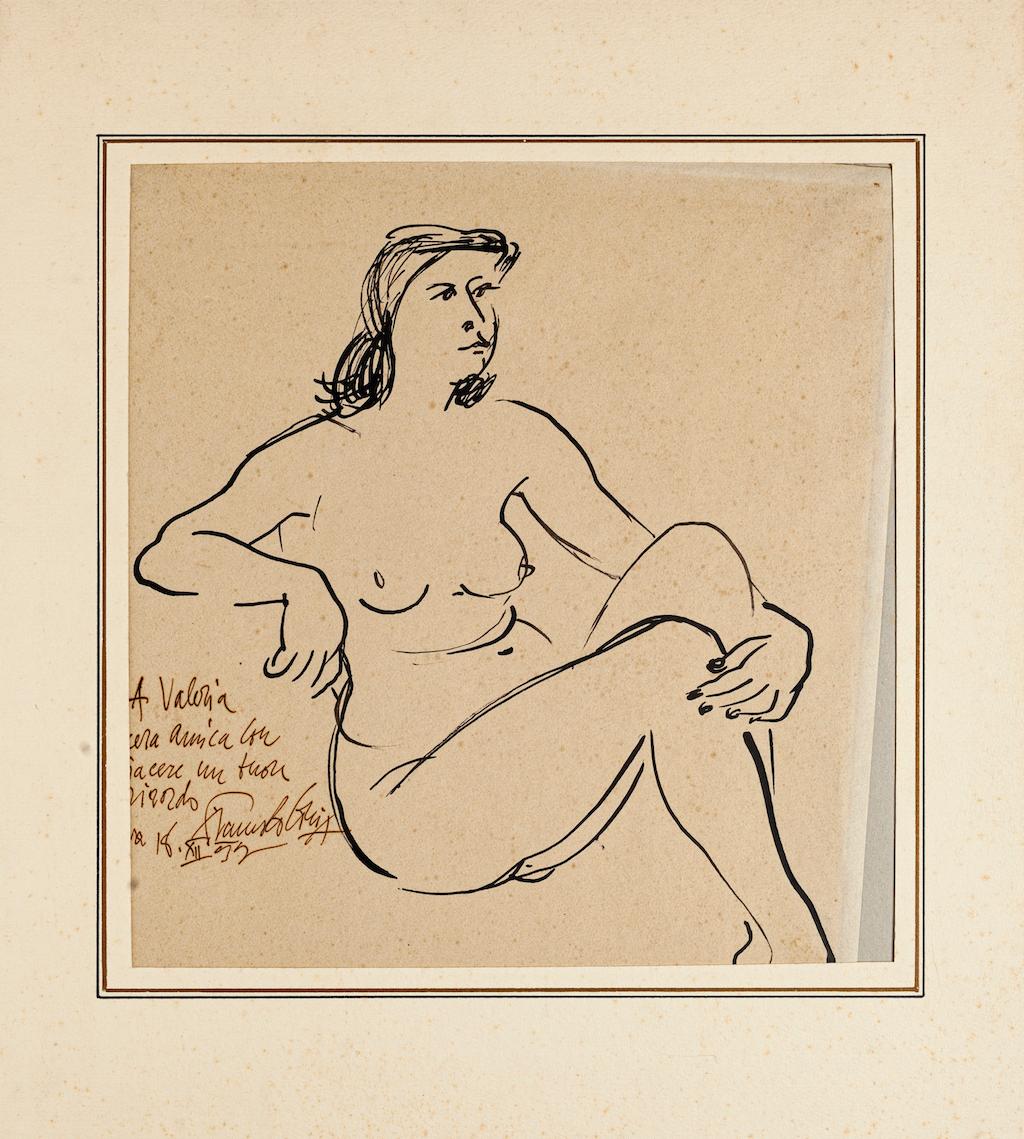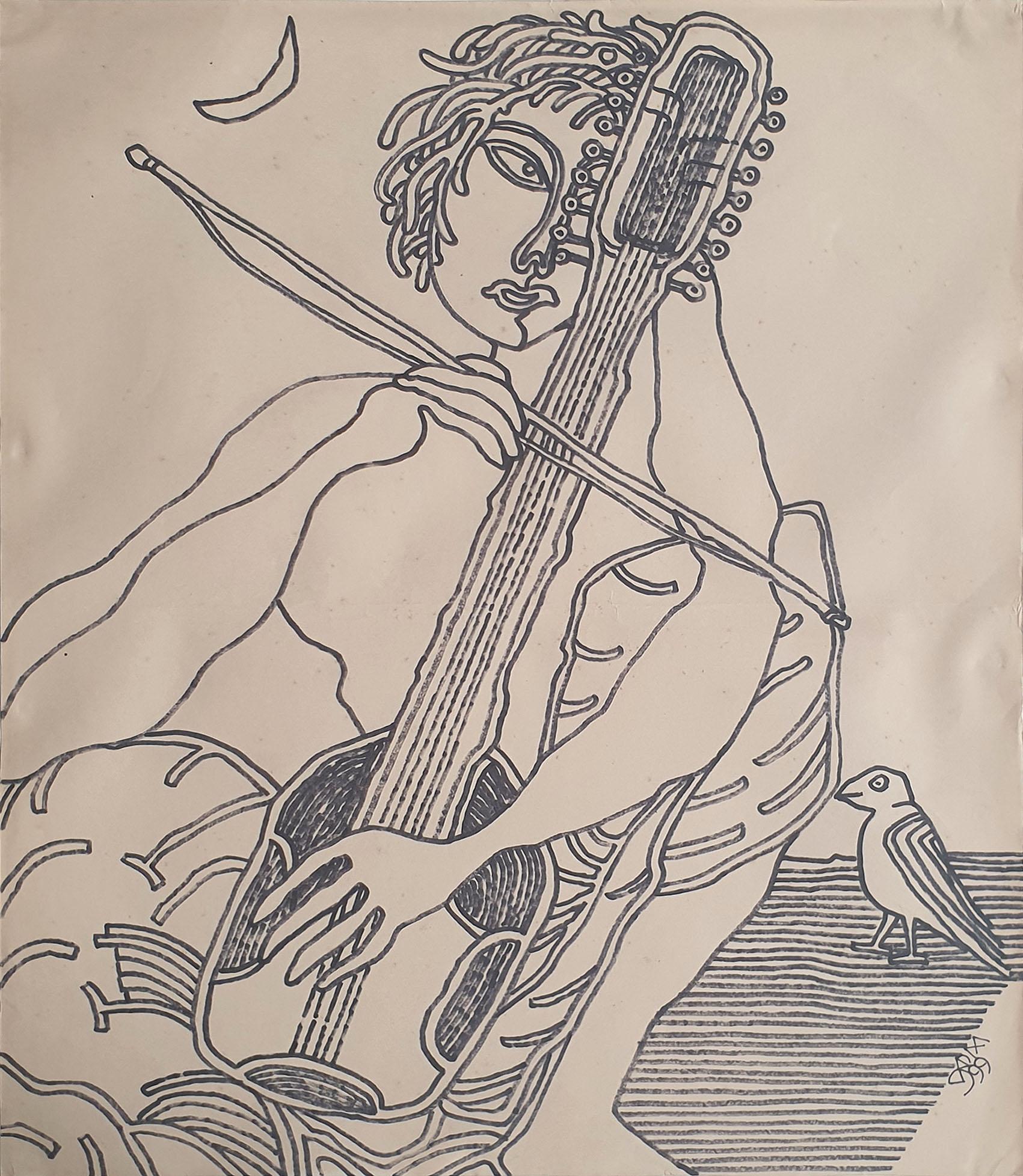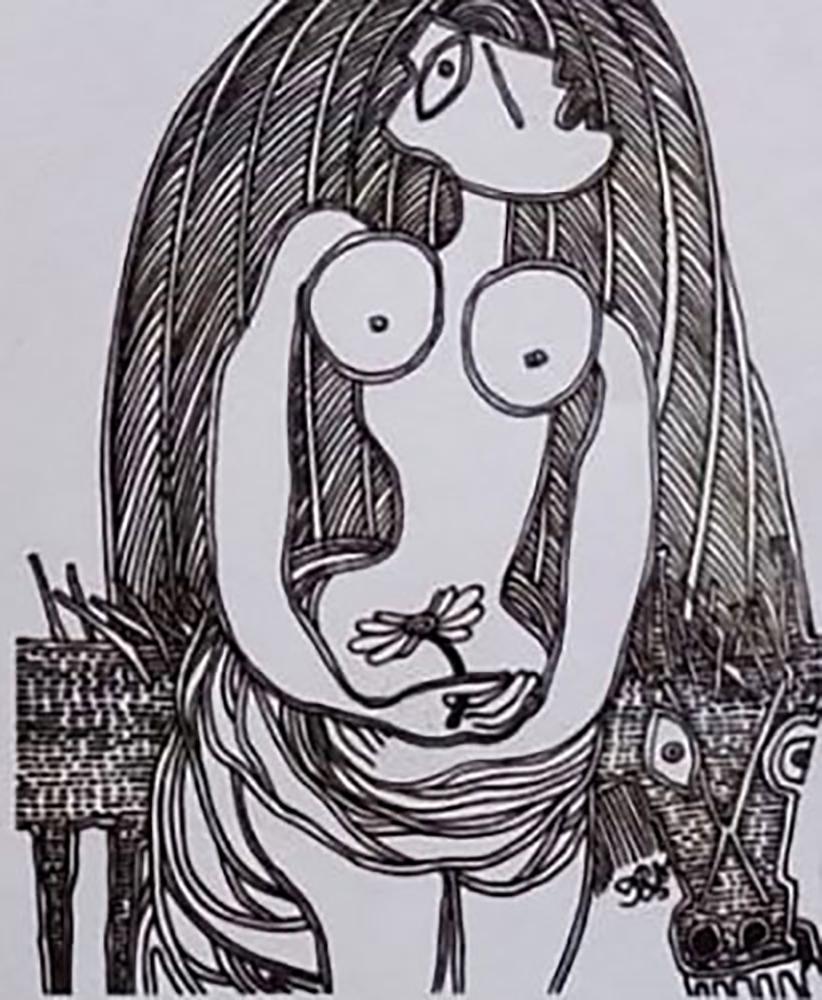Items Similar to "Reclining Figure" Walt Kuhn, Figurative Nude Line Drawing, American Modernism
Want more images or videos?
Request additional images or videos from the seller
1 of 10
Walt Kuhn"Reclining Figure" Walt Kuhn, Figurative Nude Line Drawing, American Modernism1935
1935
About the Item
Walt Kuhn
Reclining Figure, 1935
Signed and dated lower left
Pen on paper
Sight 11 x 15 inches
Provenance:
Kennedy Galleries, New York
Spanierman Gallery, New York
Private Collection, New York
Exhibited:
New York, Kennedy Galleries, Walt Kuhn, December 3 - 31, 1968, no. 71.
Walter Kuhn was born on October 27, 1877 in Brooklyn, NY. His father, Francis Kuhn, was the owner of a ship provisioning business and several New York hotels. Kuhn’s mother, Amelia Hergehan, introduced her son to art and theater at a young age. From this point forward, Kuhn’s lifelong interest in art, theater and the circus began. For the remainder of his life, employment in the entertainment industry acted as a second career and source of income for the artist. More importantly, it provided limitless inspiration for his canvases.
At the age of 15, Kuhn sold his first drawings to a magazine and began to sign his name “Walt.” In 1893, he enrolled in evening art classes at the Brooklyn Polytechnic Institute. However, he soon lost interest in becoming an artist and instead, decided to open a bicycle shop in Brooklyn. In his lifetime, Kuhn would become known for his impulsive, yet dedicated personality.
By 1899, Kuhn had become enamored with ideas of the American West, and with only $60 in his pocket, he set out for California. Upon his arrival in San Francisco, he again took up the pen and became a cartoonist for WASP magazine. In 1901, the young artist departed for Paris, where he enrolled in formal art classes at the Academy Colarossi. Finding too little discipline for his liking in Paris, Kuhn soon left for the Royal Academy in Munich, where he studied under Barbizon painter Heinrich von Zugel (1850-1941).
In 1903, he returned to New York and immersed himself in the booming art scene. While continuing to work as an illustrator for local journals, he helped manage the Kit Kat Club- an organization that raised funds for scholarships at the National Academy of Design. In 1905, he held his first exhibition at the artist run, Salmagundi Club, establishing himself as both a cartoonist and a serious painter. That same year, he submitted his first illustrations to LIFEmagazine.
Kuhn regularly spent his summers in Fort Lee, NJ— one of the early homes of the movie industry. The area provided the maturing artist with the creative environment he needed to thrive. When the New York School of Art moved to the area in the summer of 1908, Kuhn joined the faculty. However, he soon came to dislike his experience as an instructor, and when the school moved back to New York, he also went along- only this time, in separate ways.Upon his return, he married Vera Spier. The couple had one child, a daughter Brenda Kuhn.
While his home life was beginning to blossom, so was his career. In 1909, he spent the year preparing his first one-man exhibition for the Madison Gallery in New York. The show proved to be a huge success. Soon after, Kuhn took part in establishing the Association of American Painters and Sculptors- the organization responsible for the landmark Armory Show of 1913. As the executive secretary, he was responsible for finding artists to participate. The Armory Show, which displayed both European and American modern art to New York audiences for the first time, proved to be a huge success de scandale. In 1938, Kuhn published an “insider’s” viewpoint to the event in his seminal essay, “The Story of the Armory Show.” Following the exhibition, Kuhn began to explore new ways for artists to break established barriers. In 1917, he founded the Penguin Club, an organization where artists held open meetings and provided criticism for each other.
By 1925, Kuhn’s health had taken a dramatic turn when a duodenal ulcer almost killed him. After a prolonged recovery, he eventually joined the faculty of the Art Student’s League. He also took up a commission for the Union Pacific Railroad, in which he completed designs for new club cars. Almost foreseeing the end of his career, the aging artist organized his first retrospective in 1939, which took the form of a book titled, Fifty Paintings by Walt Kuhn.
By the 1940s, Kuhn’s eccentric behavior began to take on unstable forms that had never surfaced before. He became increasingly distant, and when the Ringling Brothers, Barnum and Bailey Circus was in town, he religiously attended. This particular painting is similar to that of Milton Avery's circus paintings from the same period. In consequence, his unsound demeanor did not go unnoticed, and in 1948, he was institutionalized.
Kuhn’s last years are marked with tragedy and remain a mystery. Rumors of attempted suicides plague his biographies. Nonetheless, on July 13, 1949, he died instantly from a perforated ulcer. In a bittersweet act, Vera and Brenda Kuhn placed his favorite drawing pen in his jacket pocket prior to his wake.
About the Seller
5.0
Platinum Seller
These expertly vetted sellers are 1stDibs' most experienced sellers and are rated highest by our customers.
Established in 2021
1stDibs seller since 2022
59 sales on 1stDibs
Typical response time: 1 hour
- ShippingRetrieving quote...Ships From: New York, NY
- Return PolicyA return for this item may be initiated within 3 days of delivery.
More From This SellerView All
- "Nude with Hand on Hip Leaning Against Chair" Joseph Delaney, African-AmericanLocated in New York, NYJoseph Delaney Nude with Hand on Hip Leaning Against Chair, circa 1935 Signed lower right Watercolor on paper Sight 12 x 8 inches Provenance: Sacks Fine Art, New York Private Collection, New York African-American artist Joseph Delaney was a folk-expressionist painter who loved New York City, both as a subject for painting and the spectacle and experience of ever-changing life and vitality. Of the city, he said: "The curtain goes up on the stage of life every time we walk into the street. In spite of New York's being the most congested city I have been in, and know about, by and large, it's just people on the move. I have enjoyed more than I can say seeing people and hearing them speak about things they love and enjoy." Delaney, the son of a Methodist minister, was born in Knoxville, Tennessee, in 1904, the ninth of ten children. It was in church that Delaney and his older brother, Beauford, began to express their art talent by drawing on Sunday School cards. He attended school there, leaving the Knoxville Colored High School at the end of the ninth grade. The next few years were spent doing odd jobs around town (caddy at the Cherokee Country Club, bell hop at the Farragut Hotel) until leaving for Chicago around 1924, where he served three years with the National Guard. He returned to Knoxville in 1929, selling insurance and helping found the city's first black Boy Scout unit. In 1930, Delaney went to New York City, studying at the Art Students League with Thomas Hart Benton, George Bridgman and Alexander Brooke. Other students there at the time included Jackson Pollock, Henry Stair, and Bruce Mitchell. In 1932, he exhibited in the first Washington Square Outdoor Art Show. He would continue to do so for the next forty years, working as a sketch artist there, drawing such celebrities as Eartha Kitt, Arlene Francis, Eleanor Roosevelt, and Tallulah Bankhead. Delaney would spend fifty-six years living and painting in the area of lower Manhattan, SoHo and Union Square. From 1934-1940, Delaney worked for the WPA (Works' Progress Administration) on projects in New York City including the Index of Design for the Metropolitan Museum of Art, the Pier 72 mural, and the Story of the Recorded Word mural at the Public Library. He also taught at Harlem and Brooklyn settlement houses and the Art Students League while exhibiting his paintings in his studio, art galleries and other exhibitions. In 1942, Delaney received a Julius Rosenwald grant of $1200.00 to travel, sketch and later paint the Eastern seaboard. In 1964, he was a sketch artist for the New Orleans exhibit and later the Ghana exhibit at the New York City World's Fair. From 1978-1980, he worked for CETA, the Comprehensive Employment and Training Act, as an artist in residence at the Henry Street Settlement. In 1979, Delaney's brother, Beauford, died in Paris at St. Anne's Hospital, an insane asylum. Delaney paid over $6,000 to the French government for taxes, storage, and shipping, to have Beauford's art and personal effects shipped to the U.S. The University of Tennessee would figure strongly in Delaney's life. In 1970, the artist had an exhibition there, and his painting, "V-J Day, Times Square", was added to their collection. In 1986, the Ewing Gallery exhibited, "Joseph Delaney: A Retrospective," as part of the Homecoming '86 Festival. In that year, author Alex Haley...Category
1930s Modern Figurative Drawings and Watercolors
MaterialsPaper, Watercolor
- "In Foreign Parts" Eugene Higgins, Southwestern Pueblo, Modern FigurativeBy Eugene HigginsLocated in New York, NYEugene Higgins In Foreign Parts, circa 1913 Signed lower right Watercolor on paper Sight 17 x 13 inches Born William Victor Higgins in 1884 to a Shelbyville, Indiana farm family where the only art Victor was aware of as a child was his father's love of flowers. "He loved their forms and their colors, and he tended his garden as a painter might work a canvas." At the age of nine, Victor met a young artist who traveled the Indiana countryside painting advertisements on the sides of barns. He purchased paints and brushes so the young Higgins could practice his own artwork on the inside of his father's barn. He also taught Victor about art museums and especially about the new Chicago Art Institute. This information never left the young artist, and he saved his allowance until his father allowed him at the age of fifteen to attend Chicago Art Institute. He worked a variety of jobs to finance his studies both there and at the Academy of Fine Arts. Victor Higgins traveled to New York in 1908, where he met Robert Henri, who became a significant influence by depicting every-day scenes and stressing the importance of the spirit and sense of place as important factors in painting. Higgins was also greatly affected by the New York Armory Modernism Show of Marsden Hartley in 1913. While Victor Higgins was in Chicago he met former mayor and avid collector Carter H. Harrison who was to prove instrumental in the growth of Higgins career for several years. Harrison agreed to support Higgins for four years to go to Paris and Munich and paint and study in the great museums in Europe. While at the Academie de la Grande Chaumier in Paris (1910-1914) he met Walter Ufer, who was another Chicago artist being sponsored by Carter Harrison. This meeting was not only a life-long friendship, but the beginning of a great change in the way Higgins looked at "American" art. He decided that America needed it's own authentic style rather than the 19th Century classic style he was taught in Europe. Very soon after returning to Chicago in 1914, Harrison sent him and Walter Ufer on a painting trip to Taos, New Mexico for a year in exchange for paintings. Higgins made other similar agreements and was able to support himself with his painting. This trip was a life-changing experience and introduced Higgins to the authentic America he had been looking for. In 1914 Taos was an isolated village about twelve hours from Santa Fe on an impossible dirt road. But the colorful life of the pueblo people and the natural beauty drew a collection of artists who became the Taos art colony, from which the Taos Society of Artists was founded in 1915. Victor Higgins became a permanent resident within a year of his arrival and a member of the society in 1917, exhibiting with Jane Peterson in 1925 and with Wayman Adams and Janet Scudder in 1927. The members would travel around the country introducing the Southwest scenes with great success. He remained a member until the Society's dissolution in 1927. Higgins was the youngest member of the group of seven. Other members were Joseph Henry Sharp, Bert Phillips...Category
1910s American Modern Figurative Drawings and Watercolors
MaterialsWatercolor, Paper
- "Untitled" Bob Thompson, Figurative Work on Paper, Black Abstract ArtistBy Bob ThompsonLocated in New York, NYBob Thompson Untitled, 1964 Felt tip pen on printed paper 11 x 20 1/2 inches Provenance: The artist Kathy Komaroff Goodman (gift from the artist) Hollis Taggart, New York Exhibited...Category
1960s Modern Figurative Drawings and Watercolors
MaterialsWatercolor, Paper
- "March Avery in Beret, " Milton Avery, American Modernism, Portrait of ArtistBy Milton AveryLocated in New York, NYMilton Clark Avery (1885 - 1965) March Avery in a Beret, 1951 Black crayon and graphite on cream wove paper 11 x 8 3/8 inches Signed and dated lower left; ...Category
1950s American Modern Portrait Drawings and Watercolors
MaterialsPaper, Crayon, Pencil, Graphite
- Out of the Sun (Under the Racetrack Grandstand), Saratoga Springs, Anne DiggoryBy Anne DiggoryLocated in New York, NYAnne Diggory (b. 1951) Out of the Sun (Under the Racetrack Grandstand), 1978 Watercolor on paper 7 x 10 inches Signed and dated lower left Provenance: Ac...Category
1970s Contemporary Landscape Drawings and Watercolors
MaterialsPaper, Watercolor, Pencil
- "Medieval Thoughts, Prague, " Alphonse Mucha, Czech Art Nouveau IllustrationBy Alphonse MuchaLocated in New York, NYAlphonse Mucha (Czech, 1860 - 1939) Medieval Thoughts, circa 1890 Wash, ink, and watercolor on paper 11 x 9 inches Signed lower right Provenance: Phillips New York, 19th and 20th ce...Category
1890s Art Nouveau Figurative Drawings and Watercolors
MaterialsPaper, Ink, Watercolor
You May Also Like
- Nude - Pen on Ivory Paper by Fausto Ghia - 1955Located in Roma, ITNude is an original drawing in pen on ivory paper realized by Fausto Ghia. Hand-signed on the lower left with dedication. The state of preservation is very good. Included a Passep...Category
1950s Modern Figurative Drawings and Watercolors
MaterialsPaper, Pen
- Woman seated in Garden, Nude, Ink on paper by Modern Indian Artist "In Stock"By Prakash KarmarkarLocated in Kolkata, West BengalPrakash Karmakar - Untitled - 23 x 20 inches Marker on Paper , 2002 Delivery of shipment in roll form. Style : Legendary master artist Lt. Prokash Karmakar from Bengal was solely re...Category
Early 2000s Modern Figurative Drawings and Watercolors
MaterialsPaper, Ink, Permanent Marker
- Woman playing Sitar, Nude, Ink on paper by Modern Indian Artist "In Stock"By Prakash KarmarkarLocated in Kolkata, West BengalPrakash Karmakar - Untitled - 23 x 20 inches Marker on Paper , 1999 Delivery of shipment in roll form. Style : Legendary master artist Lt. Prokash Karmakar from Bengal was solely re...Category
Early 2000s Modern Figurative Drawings and Watercolors
MaterialsInk, Permanent Marker, Paper
- Nude Woman, Long Hair, Drawings, Marker on paper, Modern Indian Artist"In Stock"By Prakash KarmarkarLocated in Kolkata, West BengalPrakash Karmakar - Untitled - 23 x 20 inches (unframed size) Marker on paper Delivery of shipment in roll form. Style : Legendary master artist Lt. Prokash Karmakar from Bengal was ...Category
Early 2000s Modern Figurative Drawings and Watercolors
MaterialsPaper, Ink, Permanent Marker
- Woman with Horse, Nude, Ink on paper by Modern Indian Artist "In Stock"By Prakash KarmarkarLocated in Kolkata, West BengalPrakash Karmakar - Untitled - 23 x 20 inches Marker on Paper , 1999 Delivery of shipment in roll form. Style : Legendary master artist Lt. Prokash Karmakar from Bengal was solely re...Category
Early 2000s Modern Figurative Drawings and Watercolors
MaterialsPermanent Marker, Paper, Ink
- Woman with Flower, Nude, Marker on paper by Modern Indian Artist "In Stock"By Prakash KarmarkarLocated in Kolkata, West BengalPrakash Karmakar - Untitled - 23 x 20 inches (unframed size) Marker on paper Delivery of shipment in roll form. Style : Legendary master artist Lt. Prokash Karmakar from Bengal was ...Category
Early 2000s Modern Figurative Drawings and Watercolors
MaterialsPermanent Marker, Paper, Ink
Recently Viewed
View AllMore Ways To Browse
Kit Kat
Walter Paris Watercolor
Watercolor Kit
Penguin Figure
Quentin Blake Art
Maritime Dream Ancient Greece
Walter Paris Watercolor
Richard Knotel
Nude Charcoal Drawings Men
Arnold Genthe San Francisco
Gustave Guillaumet
Jan Ellis
Traduzione Italiana
Edouard Legrand
Paul Allen Counts
Ruth Stewart Painting
Les Modes Parisiennes
Pierre Guastalla On Sale





